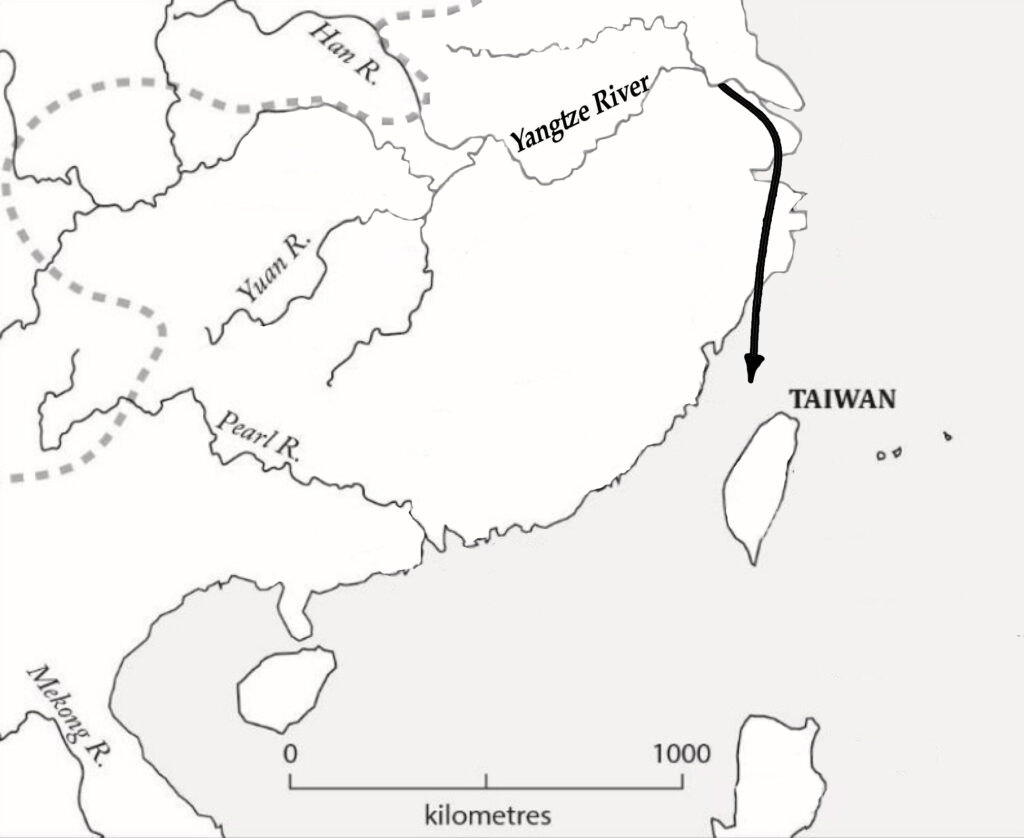4) Through China to Taiwan
(5000 BC-2500 BC)
About 5000 BC, just before the people we know as Chinese settled down in their land and before rice fields spread widely throughout the country, bands of hunters and gatherers roamed throughout eastern Asia. Different language speaking groups were very much on the move, wandering this way and that way, looking for places where they could find the resources they needed to survive.
Some of these foraging groups were already beginning to settle down on good farm land where they could cultivate rice and millet, the grain crops that were starting to become popular. The gradual switch to agriculture in southern China was just taking off at that time.
The groups who settled down to farm applied what they knew about plants to grow their own crops. They tended to settle close to rivers or pastures in hilly areas. Since they needed a source of protein, they raised domestic animals–especially larger animals such as cows and water buffalo–as an additional source of food, especially if they were far from the ocean and could not easily obtain fish. As the numbers in these new farm communities grew, they attracted craftsmen and others who did not farm but could provide special services for the community. Eventually, as the community became more complex, the people required leaders with powers greater than those of the tribal chiefs who had guided them when they were still wandering from place to place. As the community grew, ceremonial centers were built for the worship of high gods rather than simply the nature spirits that they had honored as they were moving from place to place.
Not all the wandering bands were ready to settle down, however. Some of them began moving down the Yangtze River. We know very little about these people other than that they might be called “fish foragers”–tribal people who depended heavily on fish rather than land animals for protein. They also seem to have been traders. Both of these traits would serve them well as they traveled downstream toward the coast.
Perhaps they learned how to plant millet or rice at some point in their journey down the Yangtze River. But even if they could grow these crops, they remained people on the move, slowly making their way to the sea where they would depend on the sea’s resources to sustain them.
By the time these people approached the seashore, they had become experienced in building and working boats they could use for travel on the river. That gave them a head start in developing the canoes and the method of navigation they would need to sail to Taiwan. From there their skills would grow as they prepared to sail to far more distant lands.

This is the introduction of a five-part series of posts on Micronesian Origins. The full list of posts are available below. You may also browse or download the PDF below.
- Introduction – Micronesians: Where Did They Come From?
- Ch 1) Back to the First Settlement of Our Islands (2,000 years ago)
- Ch 2) Where the Original Settlers Come From (1400 BC – 200 BC)
- Ch 3) The Beginning of the Seafarers (2500 BC-1400 BC)
- Ch 4) Through China to Taiwan (5000 BC-2500 BC)
- Ch 5) Out of Africa (50,000 BC)

